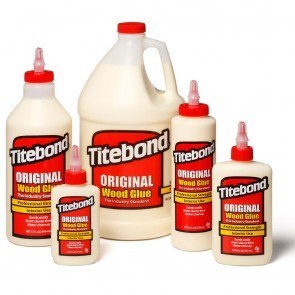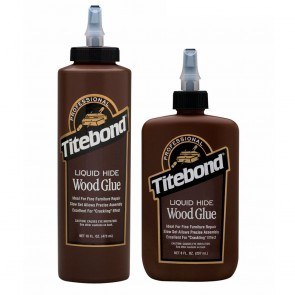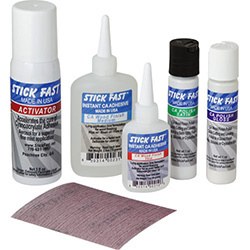Wood Glues
An adhesive is any substance applied to the surfaces of materials that binds them together and resists separation, in woodworking this is commonly refered to as glue. When working with glues one must take into consideration the open time required, does it need to be waterproof and will it have to fill a gap. Each of the common adhesives listed below have characteristics that will perform under certain conditions, there is no one size fits all, it is a matter of choosing the product for the job at hand. Most well equipped shops will have the glues listed below. |
PVA Glue
Polyvinyl acetate glue is the most common type of glue used in home workshop, it includes most of the common white and yellow carpenter glues such as Elmers and Titebond. Different brands will have additives to increase open time. tackiness, etc. depending what the glue is designed to be used for. Some formulations are waterproof such as Titebond 111. Dried glue not cleaned up properly can interfere with finishing stains. This is a strong glue, different types will allow for longer setup time for complicated projects. This glue will creep, so clamping is necessary until the glue sets. Clean up while glue is wet: Use a clean, damp cloth to wipe off excess glue. Make as many passes as needed with the clean area of the cloth to remove all the glue. When areas have completely dried, sand as needed. Get Wood Glue from Rockler.com Tip: Floss Gluing To glue a crack in a board pour some PVC glue on a scrap board, drag a length of dental floss through the puddle so it becomes saturated with glue, work the floss down through the crack, reload the floss with glue if necessary. When you get to the end of the crack remove floss and clamp the board. Hide Glue
Hide glue has been around for practically forever, made from connective tissues, hides and bones of animals mainly cattle. Hot hide glue is made by heating granules in a pot with water. it is applied hot with a brush, as it cools it solidifies. Liquid hide glue comes ready to use in a bottle much like PVA glue, it is less critical to remove every last bit of it when finishing. Clean up is best done with warm water before the glue hardens. Epoxy
This is a two part adhesive, when the parts are combined a chemical reaction occurs that causes the epoxy to harden. It is waterproof and also fills gaps with a strong bond. There are different formulas, some harden in 5 minutes, the longer setting types tend to make a stronger bond. CA Glue
Cyanoacrylate glue is commonly known as CA or Super Glue, it sets very quickly but the glue joint is very hard so can fracture under impact. This feature can be used to fasten blocks to odd shaped objects for clamping joints using PVA glue, then the blocks are given a sharp rap with a hammer and pop off. Polyurethane Glue
Polyurethane glue is activated by moisture and swells as it dries, it is a waterproof joint. Gorilla glue is a popular brand. One of the features is that it sticks to just about everything.
|




